High-Resolution Representations Network for Single Image Dehazing
Abstract
:1. Introduction
- We propose DeHRNet, which increases the receptive field of the network through parallel connections between branches of different resolutions and merges the features of branches of different resolutions at the end of each stage, effectively avoiding the issue of preserving spatial information. Moreover, we add a new stage to the original network to make it better for image dehazing. The newly added stage collects the feature map representations of all the branches of the network by up-sampling to enhance the high-resolution representations instead of only taking the feature maps of the high-resolution branches, which makes the restored clean images more natural.
- DeHRNet is an end-to-end image dehazing network; instead of using a convolutional neural network to estimate the transmission, it effectively avoids the issue of inaccurate parameter estimation.
- Compared with the existing methods, the network proposed in this paper has achieved good dehazing effects in both synthesized and natural hazy images.
2. Related Work
3. The Proposed DeHRNet
3.1. Detailed Network Structure
3.2. Loss Function
4. Results
4.1. Database
4.2. Experiment Environment
4.3. Result and Analysis
4.3.1. Experimental Results and Analysis on the Synthetic Hazy Image Test Set
4.3.2. Experimental Results and Analysis on the Real Hazy Image Test Set
4.3.3. Dehazing Time Analysis of a Single Image
5. Conclusions
Author Contributions
Funding
Institutional Review Board Statement
Informed Consent Statement
Data Availability Statement
Acknowledgments
Conflicts of Interest
References
- Chen, C.; Wu, Y.; Zhou, C.; Zhang, D. Jsrnet: A joint sampling–reconstruction framework for distributed compressive video sensing. Sensors 2020, 20, 206. [Google Scholar] [CrossRef] [PubMed] [Green Version]
- Redmon, J.; Divvala, S.; Girshick, R.; Farhadi, A. You Only Look Once: Unified, Real-Time Object Detection. In Proceedings of the IEEE Conference on Computer Vision and Pattern Recognition, Las Vegas, NV, USA, 27–30 June 2016; pp. 779–788. [Google Scholar]
- Kim, T.K.; Paik, J.K.; Kang, B.S. Contrast enhancement system using spatially adaptive histogram equalization with temporal filtering. IEEE Trans. Consum. Electron. 1998, 44, 82–87. [Google Scholar]
- Cooper, T.J.; Baqai, F.A. Analysis and extensions of the Frankle-McCann Retinex algorithm. J. Electron. Imaging 2004, 13, 85–92. [Google Scholar] [CrossRef]
- Seow, M.J.; Asari, V.K. Ratio rule and homomorphic filter for enhancement of digital colour image. Neurocomputing 2006, 69, 954–958. [Google Scholar] [CrossRef]
- Deng, G.; Cahill, L.W.; Tobin, G.R. The study of logarithmic image processing model and its application to image enhancement. IEEE Trans. Image Process. 1995, 4, 506–512. [Google Scholar] [CrossRef] [PubMed]
- Polesel, A.; Ramponi, G.; Mathews, V.J. Image enhancement via adaptive unsharp masking. IEEE Trans. Image Process. 2000, 9, 505–510. [Google Scholar] [CrossRef] [PubMed] [Green Version]
- Jiang, B.; Woodell, G.A.; Jobson, D.J. Novel multi-scale retinex with color restoration on graphics processing unit. J. Real-Time Image Process. 2015, 10, 239–253. [Google Scholar] [CrossRef]
- Narasimhan, S.G.; Nayar, S.K. Contrast restoration of weather degraded images. IEEE Trans. Pattern Anal. Mach. Intell. 2003, 25, 713–724. [Google Scholar] [CrossRef] [Green Version]
- McCartney, E.J. Optics of the Atmosphere: Scattering by Molecules and Particles; Wiley: New York, NY, USA, 1976. [Google Scholar]
- Nayar, S.K.; Narasimhan, S.G. Vision in Bad Weather. In Proceedings of the Seventh IEEE International Conference on Computer Vision, Kerkyra, Greece, 20–27 September 1999; Volume 2, pp. 820–827. [Google Scholar]
- He, K.; Sun, J.; Tang, X. Single Image Haze Removal Using Dark Channel Prior. IEEE Trans. Pattern Anal. Mach. Intell. 2011, 33, 2341–2353. [Google Scholar] [PubMed]
- Zhu, Q.; Mai, J.; Shao, L. A Fast Single Image Haze Removal Algorithm Using Color Attenuation Prior. IEEE Trans. Image Process. 2015, 24, 3522–3533. [Google Scholar]
- Ju, M.; Ding, C.; Guo, Y.J.; Zhang, D. IDGCP: Image dehazing based on gamma correction prior. IEEE Trans. Image Process. 2019, 29, 3104–3118. [Google Scholar] [CrossRef] [PubMed]
- Tang, K.; Yang, J.; Wang, J. Investigating Haze-Relevant Features in a Learning Framework for Image Dehazing. In Proceedings of the IEEE Conference on Computer Vision and Pattern Recognition, Columbus, OH, USA, 23–28 June 2014; pp. 2995–3000. [Google Scholar]
- Cai, B.; Xu, X.; Jia, K.; Qing, C.; Tao, D. DehazeNet: An End-to-End System for Single Image Haze Removal. IEEE Trans. Image Process. 2016, 25, 5187–5198. [Google Scholar] [CrossRef] [Green Version]
- Ren, W.; Liu, S.; Zhang, H.; Pan, J.; Cao, X.; Yang, M.-H. Single Image Dehazing Via Multi-Scale Convolutional Neural Networks. In Proceedings of the 14th European Conference, Amsterdam, The Netherlands, 11–14 October 2016; Springer: Cham, Switzerland, 2016; pp. 154–169. [Google Scholar]
- Li, B.; Peng, X.; Wang, Z.; Xu, J.; Feng, D. An all-in-one network for dehazing and beyond. arXiv 2017, arXiv:1707.06543. [Google Scholar]
- Ullah, H.; Muhammad, K.; Irfan, M.; Anwar, S.; Sajjad, M.; Imran, A.S.; de Albuquerque, V.H.C. Light-DehazeNet: A Novel Lightweight CNN Architecture for Single Image Dehazing. IEEE Trans. Image Process. 2021, 30, 8968–8982. [Google Scholar] [CrossRef]
- Liao, Y.; Su, Z.; Liang, X.; Qiu, B. Hdp-net: Haze Density Prediction Network for Nighttime Dehazing. In Proceedings of the Pacific Rim Conference on Multimedia, Hefei, China, 21–22 December 2018; Springer: Cham, Switzerland, 2018; pp. 469–480. [Google Scholar]
- Dong, H.; Pan, J.; Xiang, L.; Hu, Z.; Zhang, X.; Wang, F.; Yang, M.-H. Multi-Scale Boosted Dehazing Network with Dense Feature Fusion. In Proceedings of the IEEE/CVF Conference on Computer Vision and Pattern Recognition, Seattle, WA, USA, 13–19 June 2020; pp. 2157–2167. [Google Scholar]
- Engin, D.; Genç, A.; Kemal Ekenel, H. Cycle-Dehaze: Enhanced Cyclegan for Single Image Dehazing. In Proceedings of the IEEE Conference on Computer Vision and Pattern Recognition Workshops, Salt Lake City, UT, USA, 18–22 June 2018; pp. 825–833. [Google Scholar]
- Sun, K.; Xiao, B.; Liu, D.; Wang, J. Deep High-Resolution Representation Learning for Human Pose Estimation. In Proceedings of the IEEE/CVF Conference on Computer Vision and Pattern Recognition, Long Beach, CA, USA, 15–20 June 2019; pp. 5693–5703. [Google Scholar]
- LeCun, Y.; Bengio, Y.; Hinton, G. Deep learning. Nature 2015, 521, 436–444. [Google Scholar] [CrossRef] [PubMed]
- Zhang, H.; Patel, V.M. Densely Connected Pyramid Dehazing Network. In Proceedings of the IEEE Conference on Computer Vision and Pattern Recognition, Salt Lake City, UT, USA, 18–23 June 2018; pp. 3194–3203. [Google Scholar]
- Shao, Y.; Li, L.; Ren, W.; Gao, C.; Sang, N. Domain Adaptation for Image Dehazing. In Proceedings of the IEEE/CVF Conference on Computer Vision and Pattern Recognition, Seattle, WA, USA, 13–19 June 2020; pp. 2808–2817. [Google Scholar]
- Wu, H.; Qu, Y.; Lin, S.; Zhou, J.; Qiao, R.; Zhang, Z.; Xie, Y.; Ma, L. Contrastive Learning for Compact Single Image Dehazing. In Proceedings of the IEEE/CVF Conference on Computer Vision and Pattern Recognition, Nashville, TN, USA, 20–25 June 2021; pp. 10551–10560. [Google Scholar]
- Wang, Z.; Bovik, A.C.; Sheikh, H.R.; Simoncelli, E.P. Image quality assessment: From error visibility to structural similarity. IEEE Trans. Image Process. 2004, 13, 600–612. [Google Scholar] [CrossRef] [PubMed] [Green Version]
- Li, B.; Ren, W.; Fu, D.; Tao, D.; Feng, D.; Zeng, W.; Wang, Z. Reside: A benchmark for single image dehazing. IEEE Trans. Image Process. 2018, 28, 492–505. [Google Scholar] [CrossRef] [PubMed] [Green Version]

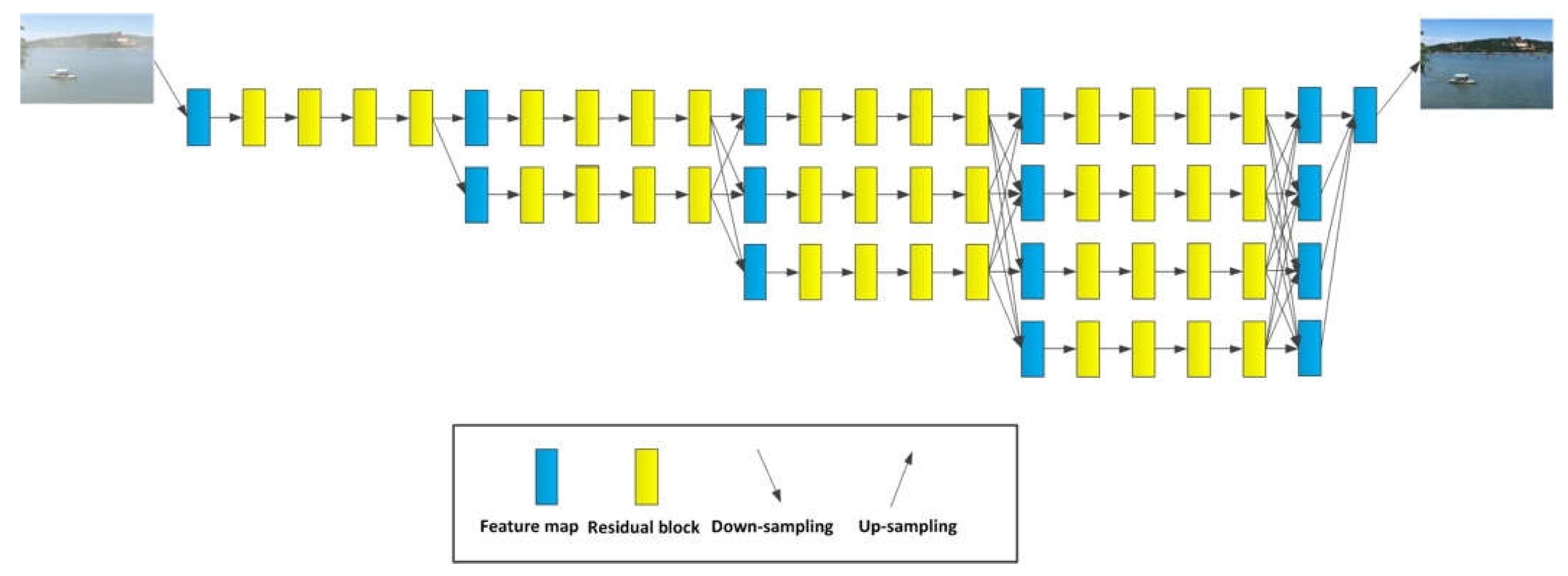
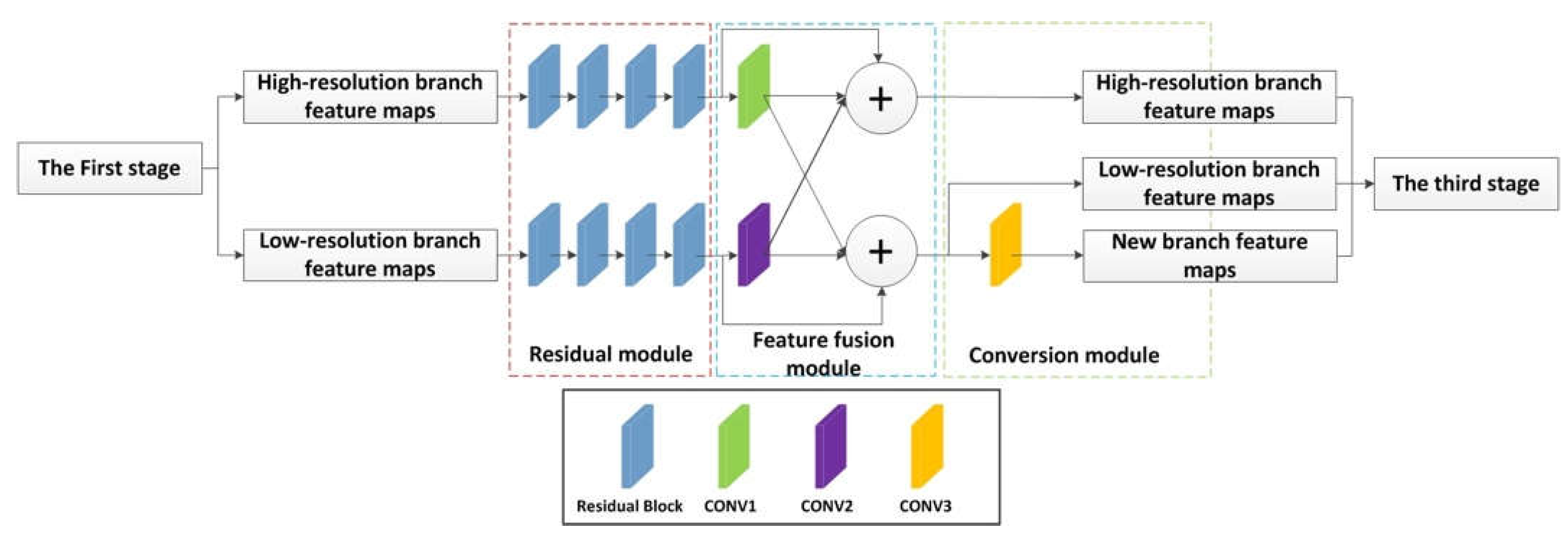
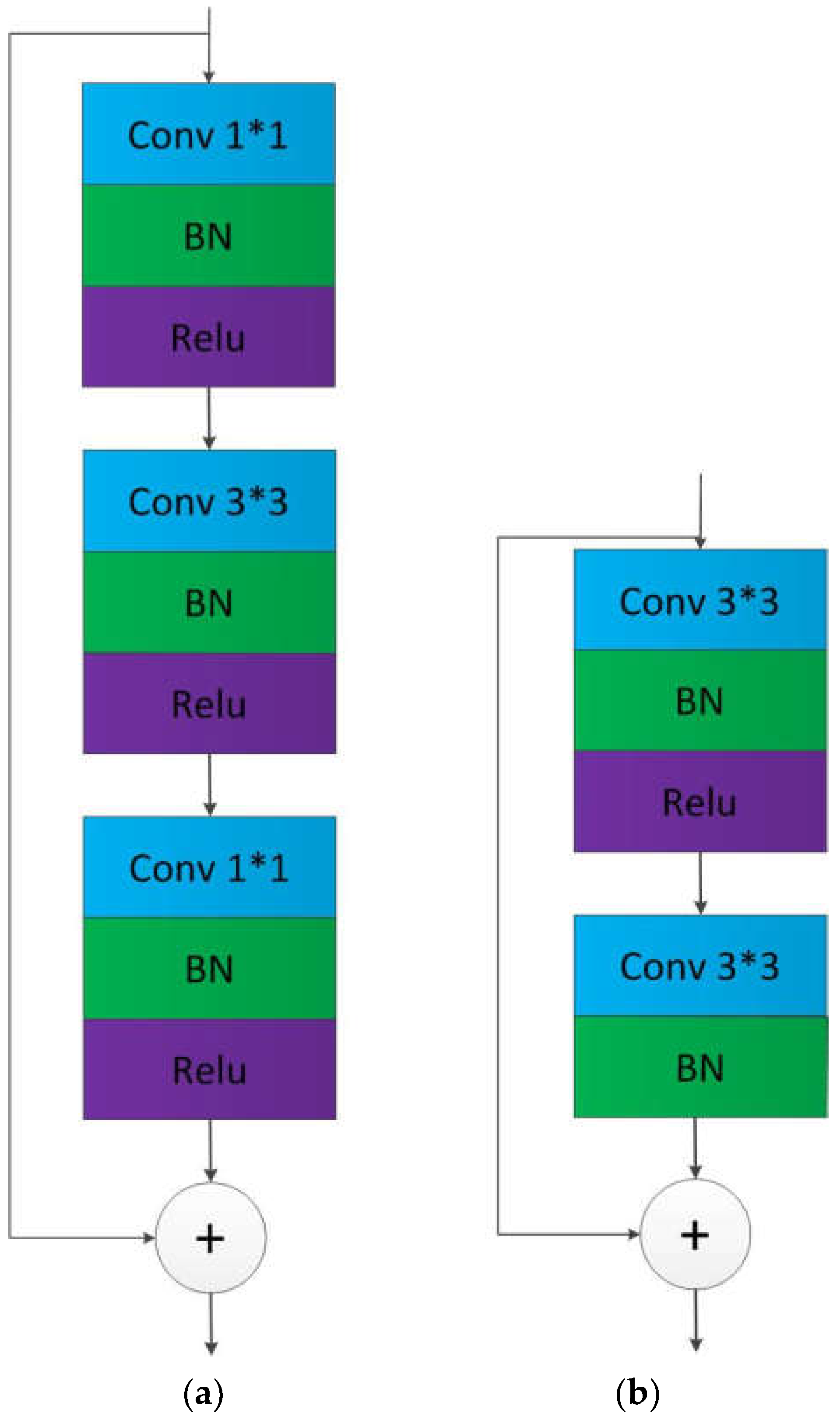
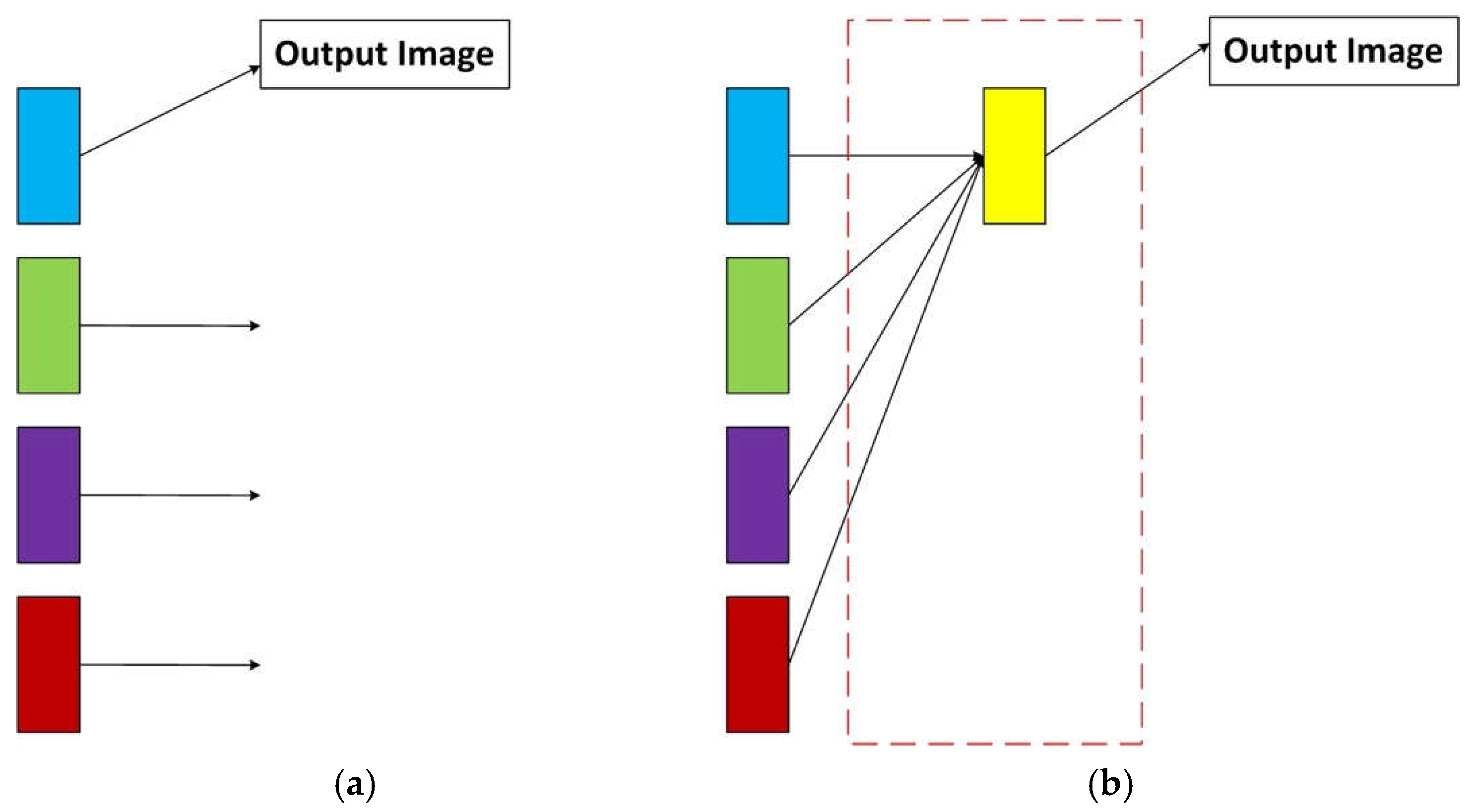

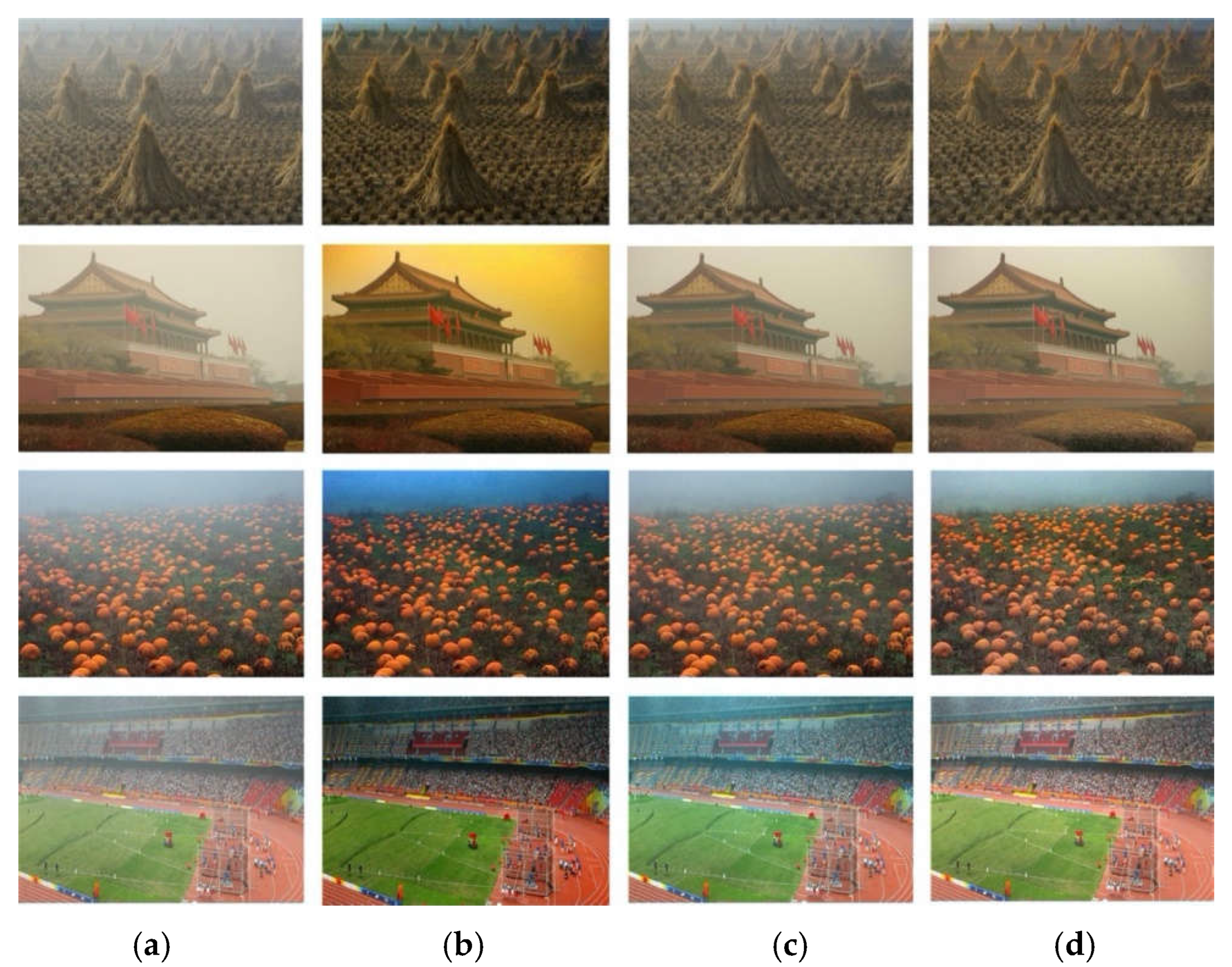
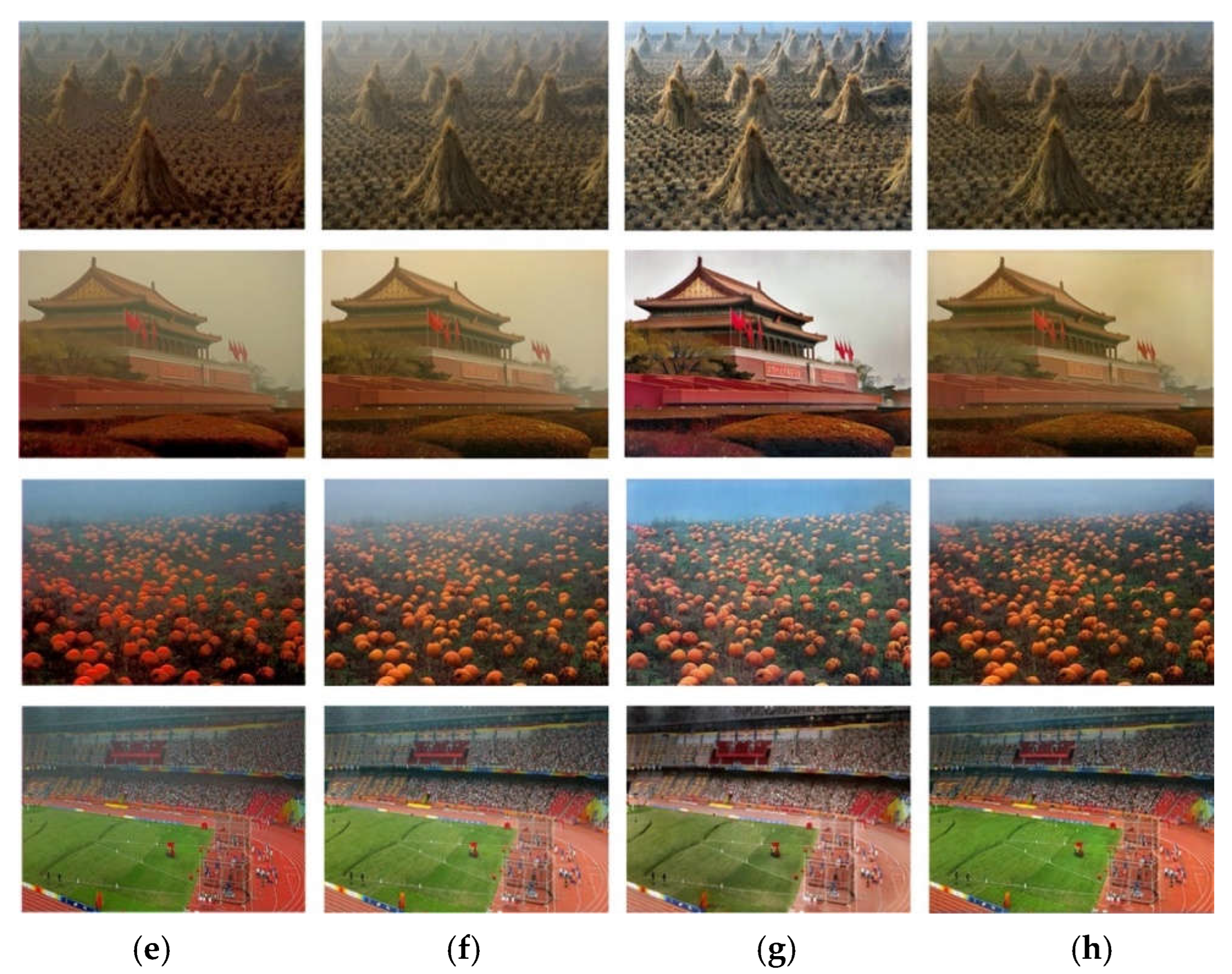
| Type | Input Image Channel Number | Filter | Filter Number | Stride |
|---|---|---|---|---|
| Conv1 | 32 | 64 | 2 | |
| Conv2 | 32 | 32 | 1 | |
| Conv3 | 64 | 128 | 2 |
| Algorithm | Evaluation Indicators | |
|---|---|---|
| PSNR | SSIM [28] | |
| DCP [12] | 16.94 | 0.8548 |
| CAP [13] | 22.30 | 0.9053 |
| DehazeNet [16] | 22.31 | 0.6828 |
| AOD-Net [18] | 19.58 | 0.8390 |
| MSBDN [21] | 30.61 | 0.9396 |
| DA-dahazing [26] | 22.84 | 0.8845 |
| The original network | 20.97 | 0.7523 |
| Ours | 23.15 | 0.8013 |
| Algorithms | DehazeNet | AOD-Net | MSBDN | DA-Dahazing | Our |
|---|---|---|---|---|---|
| Time (s) | 4.93 | 3.24 | 0.47 | 0.17 | 0.40 |
Publisher’s Note: MDPI stays neutral with regard to jurisdictional claims in published maps and institutional affiliations. |
© 2022 by the authors. Licensee MDPI, Basel, Switzerland. This article is an open access article distributed under the terms and conditions of the Creative Commons Attribution (CC BY) license (https://creativecommons.org/licenses/by/4.0/).
Share and Cite
Han, W.; Zhu, H.; Qi, C.; Li, J.; Zhang, D. High-Resolution Representations Network for Single Image Dehazing. Sensors 2022, 22, 2257. https://doi.org/10.3390/s22062257
Han W, Zhu H, Qi C, Li J, Zhang D. High-Resolution Representations Network for Single Image Dehazing. Sensors. 2022; 22(6):2257. https://doi.org/10.3390/s22062257
Chicago/Turabian StyleHan, Wensheng, Hong Zhu, Chenghui Qi, Jingsi Li, and Dengyin Zhang. 2022. "High-Resolution Representations Network for Single Image Dehazing" Sensors 22, no. 6: 2257. https://doi.org/10.3390/s22062257
APA StyleHan, W., Zhu, H., Qi, C., Li, J., & Zhang, D. (2022). High-Resolution Representations Network for Single Image Dehazing. Sensors, 22(6), 2257. https://doi.org/10.3390/s22062257






